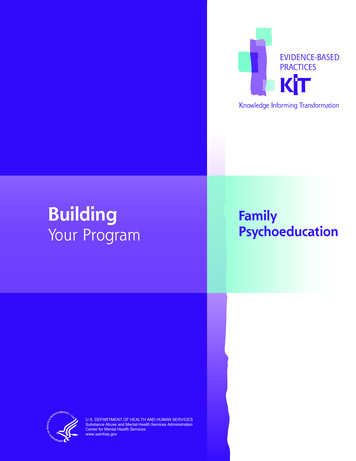
Transcription
Chapter 5Current Symptoms Self-Report FormWeek of:PSYCHOEDUCATIONPlease1:checkthe response next toeachSOCIALitem that bestdescribes your behavior during the past week.Instructions:PARTBACKGROUNDONANXIETYTimeline: Typically one sessionNever orRarelyReading: Chapter 1 in Client Workbook1Fail to give close attention to details or make carelessPhotocopiesmistakesin my workneeded from Client Workbook:2Fidgetwith2.3handsPhysicalor feet or squirmin seatFigureSymptoms3Have difficulty sustaining my attention in tasks orFigure2.5 Thoughts Related to anfunactivities4Leave my seat in situations in which seating isFigure 2.8 Monitoring the Threeexpected5SessionOutlineChapterDon’tlisten whenspokenforto directly6Feel restless7Don’t follow through on instructions and fail tofinish workA. Chapter 1 in Client Workbook8Have difficulty engaging in leisure activities or doingfun things quietly 1. Basic information about9Have difficulty organizingtasks and activities2. InformationaboutI.SometimesOftenVery Oftenof Social Anxiety that I ExperienceAnxiety-Provoking SituationComponents of Anxiety1 in Client WorkbookSet agenda for sessionsocial anxietyhow this treatment program works10Feel “on the go” or “driven by a motor”11Avoid, dislike, or am reluctant to engage in work thatrequireseffort (feeling nervousII. sustainedSocialmentalanxiety12Talk excessively13Lose things necessary for tasks or activities14A. VignettefromhaveClientBlurt out answersbefore questionsbeen Workbook:completed15Am easily distracted161. turnAnticipatoryHave difficulty awaiting17Am forgetful in dailywantsactivitiespromotion,18Interrupt or intrude on othersB. Any other matters that need to be handled for a given clientaround other people) is a normal part oflife; illustrate with case vignette of normal levels of social anxietyNicole is starting new job and mustmake a presentation to the manager’s meetinganxiety symptoms: questioning whether she really“butterflies in stomach,” feeling tense2. Anxiety increases as begins presentation: palpitations, seesFrom R. A. Barkley & K. R. Murphy (1998), Attention-Deficit Hyperactivity Disorder: A clinical workbook (2nd ed.). New York: Guilford Press.facesReprinted with permission.Masterylooking at her, stumbles over words initiallyTreatments That Work Managing Social AnxietyTMCopyright Oxford2006 OxfordUniversityPressCopyright 2005UniversityPress
3. Uses good coping statementsa) “I’m prepared.”b) “No one expects me to be perfect on the first day.”4. As presentation continues, anxiety decreases as she noticessafety cues such as everyone listening attentively5. Positive outcome after presentationa) Nicole wonders why she was so anxious beforepresentation as it went wellb) Nicole feels more optimistic about the job after facing herfearsB. Nicole’s experience is an example of social anxiety1. Public speaking is a commonly feared situation2. Nicole’s symptoms are consistent with what people typicallyreport3. Normal social anxiety is experienced by people in unfamiliar orinfrequently occurring situationsa) Speaking in front of a groupb) Meeting with a new boss or job interviewc) Going to a new class or job where you do not knowanyoned) Getting to know a potential dating partnerC. Typically social anxiety is unpleasant but not unmanageable anddecreases quickly once the situation is facedCopyright 2006 Oxford University Press
III.Clinically severe social anxiety is different than normal levels of socialanxiety; illustrate with case vignette of social anxiety disorderA. Vignette from Client Workbook: Cory is a 30-year-old man in his firstromantic relationship who is meeting his prospective in-laws for the firsttime1. Serious anticipatory anxietya) Started a week before the dinner and increased as timeapproachedb) Tension and worry about the dinner dominated hisexperience during the preceding weekc) Nausead) Worried about making a bad impression on her parentsthat would embarrass Jodi and cause relationship to ende) Anxiety interferes with concentration while driving torestaurant2. Anxiety very severe as he meets Jodi’s parents and continuesto be a problem throughout dinnera) Severe palpitationsb) Sweaty palmsc) Believes father is evaluating him negatively because helooks anxiousd) Trouble concentrating on conversatione) Escapes before coffee and dessert by making excusesCopyright 2006 Oxford University Press
3. Later Jodi said that she thought the evening went well; herparents noticed Cory’s anxiety but did not draw negativeconclusionsIV.Compare and contrast normal and clinically severe social anxiety aspresented in the vignettes to illustrate that social anxiety exists on acontinuum of severityA. Differences in intensity of symptomsB. Differences in duration of anticipatory anxietyC. Differences in how much symptoms interfered with functioningD. The important question is not whether someone experiences socialanxiety or not (most of us do), but how much and how often weexperience social anxietyE. Social anxiety exists on a continuum of less severe to more severe1. Contrast with a broken arm, which is an all-or-nothing event2. Re-examine both scenarios by describing how the anxiety couldhave been more or less severe in each set of circumstancesV.Define social anxiety, social phobia, and social anxiety disorderA. Social anxiety disorder vs. social phobia1. Social anxiety disorder is new name for what has traditionallybeen called social phobia2. In Client Workbook, use “social phobia” in Chapter 9 for specificsocial fears, such as one’s hand shaking while writing in front ofothersCopyright 2006 Oxford University Press
B. DSM-IV definition of social anxiety disorder1. Core features: fear of being negatively evaluated by others,doing something humiliating or embarrassing in front of others,others seeing one’s anxiety2. Situations in which someone is concerned about what othersthink vary widely; common situations include:a) Public speakingb) Conversations with unfamiliar peoplec) Datingd) Being assertivee) Eating or drinking in front of other peoplef)Being the center of attentiong) Talking with supervisors or other authority figuresh) Urinating in a public bathroom (usually only men)i)Intimate sexual situations3. Regardless of the specific situation, persons with social anxietydisorder share a common fear that other people will think poorly ofthem4. Other criteriaa) Realizing that the fear is excessiveb) Avoiding the situations that cause anxiety or enduringthem despite high levels of anxietyCopyright 2006 Oxford University Press
c) Social anxiety disorder must interfere with the person’slife in important ways or there must be great distress athaving the fearsC. Social anxiety disorder versus social anxiety1. Social anxiety disorder is diagnostic label with specific DSM-IVcriteria2. Social anxiety refers to the distress a person might experiencewhen interacting with or performing in front of other peoplea) Social anxiety is normal experience that may not be aproblemb) More severe social anxiety or if it occurs in manysituations might become (or be labeled as) social anxietydisorderc) If social anxiety is a problem, even if one does nottechnically meet criteria for the disorder, this treatment isprobably appropriateVI.Help client consider how his/her concerns could be described as socialanxiety, social anxiety disorder, and/or social phobiaA. Compare how client’s experience relates to vignettesB. Watch for any doubts that social anxiety describes what client isexperiencingCopyright 2006 Oxford University Press
1. Separate doubts about whether treatment can be successfulfrom agreement with therapist on conceptualization of thepresenting problem2. Do not move on until some level of agreement that client isexperiencing social anxietyVII.Overview of This Treatment ProgramA. Continue education about social anxietyB. Learn to analyze anxiety and start monitoring anxiety on a daily basisC. Learn cognitive restructuring skills to help control anxietyD. Gradually begin to practice situations that are difficult, starting withinsession and with easier situations firstE. Learn to apply cognitive restructuring skills to manage anxiety in fearedsituationsF. Learn how to consolidate gains and prepare to finish treatment with thetherapistVIII.Evidence for effectiveness of the treatment programA. No guarantees but research suggests that CBT is helpful for mostpeople with social anxiety disorderB. Research data1. Comparison of this treatment to educational-supportive grouptherapya) 12 weeks of group treatmentCopyright 2006 Oxford University Press
b) 75% of clients in cognitive-behavioral treatment classifiedas “improvers,” indicating major improvement in symptomsand sub-clinical severity of social anxiety and avoidancec) Greater percentage of “improvers” than in credibleeducational-supportive group treatmentd) Six month post-treatment follow-up – most judged to beimprovede) At 5-year follow-up, still doing well and better thaneducational-supportive group treatment2. At least 10 other studies from around the world with hundreds ofclients found CBT to be very helpful for social anxiety3. Overall, in Heimberg, Hope, and colleagues’ research, about80% of the participants are classified as “improvers” or“responders” to treatment (similar percentages in group versusindividual treatment)4. Comparison of cognitive-behavioral treatment to phenelzine(Nardil), a highly studied medication for social anxiety disordera) Phenelzine and CBT about equally effective butmedication works fasterb) About 50% relapse when they go off phenelzine (similarto rates for more recently developed medications, such asthe selective serotonin reuptake inhibitors, 30-60%)Copyright 2006 Oxford University Press
c) Individuals in CBT do not tend to relapse when therapyendsIX.How clients can get the most out of this programA. Seriously invest in change1. Personal change is hard work2. Need to set aside time at least several times a week to work onsocial anxiety3. Need to make an emotional investment by being willing toexperience anxiety4. Share slogan: Invest Anxiety in a Calmer Future5. Need to make an emotional investment by being honest withself and therapist and thoughts and fearsB. Do the exercises carefully and practice procedures frequentlyC. Persevere!1. Keep working even if the benefits are not immediately apparent;small improvements lead to larger ones2. Watch self-monitoring data to track improvementD. Avoid “disqualifying the positive” as socially anxious individuals areoften their own worst criticsE. Be willing to try new ways and give up old ways of dealing with socialanxiety1. Must be willing to give up drugs or alcohol to help control youranxietyCopyright 2006 Oxford University Press
2. Must be willing to give up PRN (“as needed”) prescriptionmedication for anxiety when doing exposuresF. Emphasize that whether this program works for a given client is underhis/her control. If clients commit the time and energy, they are likely tosee benefits.X.Assign Homework:A. Review Chapter 1 and read Chapter 2B. Complete the following forms from Chapter 21. Figure 2.3 Physical Symptoms of Social Anxiety that IExperience2. Figure 2.5 Thoughts Related to an Anxiety-Provoking Situation3. Figure 2.8 Monitoring the Three Components of AnxietyCopyright 2006 Oxford University Press
V. Define social anxiety, social phobia, and social anxiety disorder A. Social anxiety disorder vs. social phobia 1. Social anxiety disorder is new name for what has traditionally been called social phobia 2. In Client Workbook, use "social phobia" in Chapter 9 for specific social fears, such as one's hand shaking while writing in front .











